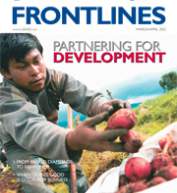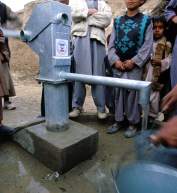- Agriculture and Food Security
- Democracy, Human Rights and Governance
- Economic Growth and Trade
- Education
- Environment and Global Climate Change
- Frontiers in Development
- Gender Equality and Women's Empowerment
- Global Health
- Science, Technology and Innovation
- Water and Sanitation
- Working in Crises and Conflict
Disaster Risk Reduction
Investing in Programs to Save Lives and Resources
In 2011, natural disasters took the lives of nearly 30,000 people, affected more than 200 million others, and caused a record $366 billion in economic damage.
The impact of future disasters is likely to be even more devastating. Disasters are expected to become more frequent in the future and to take a greater toll due to climate change, a growing world population, and more people settling in hazard-prone areas.
USAID helps countries and communities prepare by preventing or reducing the damage caused by hazards like earthquakes, floods, droughts, and storms. For example:
- Early warning systems notify people before a tsunami hits or before a volcano erupts, giving them time to move out of harm's way.
- Analysis of hazards and vulnerabilities can help communities plan where and how to build.
- Establishment and enforcement of building codes means structures are likely to withstand damage.
- Trained first responders can immediately act to rescue trapped or injured persons.
- A family with more than one means of support can protect against destitution if its primary livelihood, raising cattle for example, is decimated by drought.
Investments in disaster risk reduction save lives, not just after the disaster occurs, but even as disaster strikes.
With each disaster, development gains may be lost as infrastructure is destroyed, poverty increases, and economic opportunities and livelihoods are interrupted or lost.
USAID takes a three-pronged approach to disaster risk reduction:
- We invest in early warning, preparedness, mitigation, and prevention efforts.
- We integrate preparedness and mitigation with disaster response, early recovery, and transition so that communities "build back better" after a disaster.
- We support the diversification of livelihood strategies to enhance household resilience.
"Interwoven through all of its activities, USAID/OFDA strives to uphold the following three cross-cutting commitments:
- Building Capacity at All Levels - This may be the most important aspect of building national and local resilience and includes all of the training and technical assistance USAID/OFDA provides throughout the world. Local ownership and leadership of DRR efforts is the ultimate goal and critical to their effectiveness and long-term sustainability.
- Fixing the Gap between Early Warning Systems and Early Action - Over the past 30 years, USAID/OFDA and its partners have worked hard to establish a number of early warning systems to alert relevant communities about the impending threats of a variety of hazards. One current and future focus is to now improve systems and triggers that generate early action to save lives and livelihoods.
- Partnerships and Joint Action - Disaster risk reduction is multifaceted and long-term work. Leadership of partner governments is central to the effort, as emphasized in the HFA. USAID/OFDA endeavors to work in partnership in all of its disaster risk reduction efforts, whether with governments, regional organizations, international organizations, NGOs and civil society, the private sector, and militaries where appropriate, to multiply the impact of its action."
Since 1989 USAID has:
- Supported disaster risk reduction efforts in 119 countries.
- Trained over 70,000 people in emergency management and disaster response in Latin America and the Caribbean alone.
- Helped establish 17 global, regional, or national early warning systems.
- Brought the Incident Command System to more than 15 countries, 2 regional organizations, and 1 United Nations agency through an agreement with the U.S. Forest Service.
With limited global resources to respond to more frequent and larger-scale emergencies, appropriate preparedness and mitigation investments safeguard development gains by fostering resilience at individual, household, community, and national levels.
#IDDR from:theOFDA
-
theOFDA
Women and Girls Reduce Disaster Risk Every Day t.co/ZGNjnYIf #IDDR
4 days 16 hours ago.








Comment
Make a general inquiry or suggest an improvement.